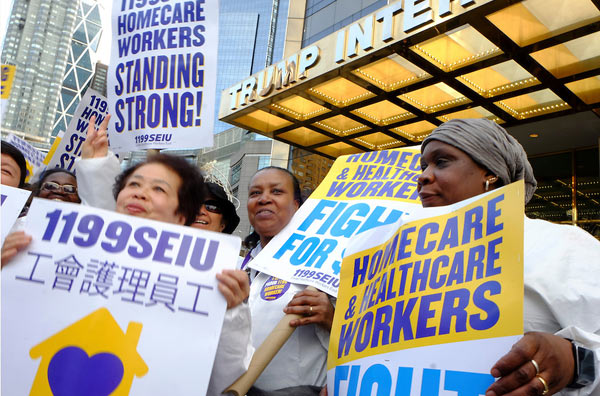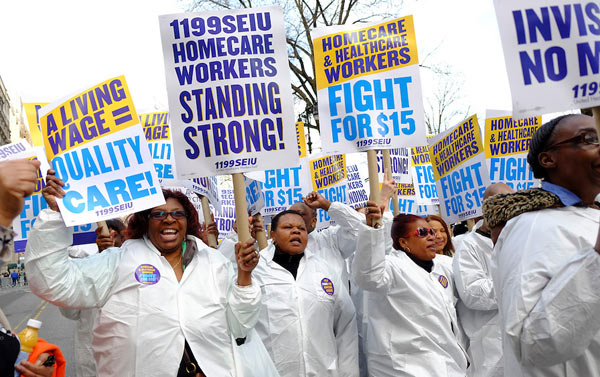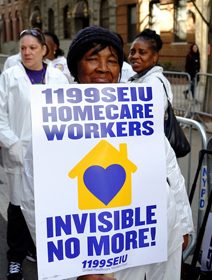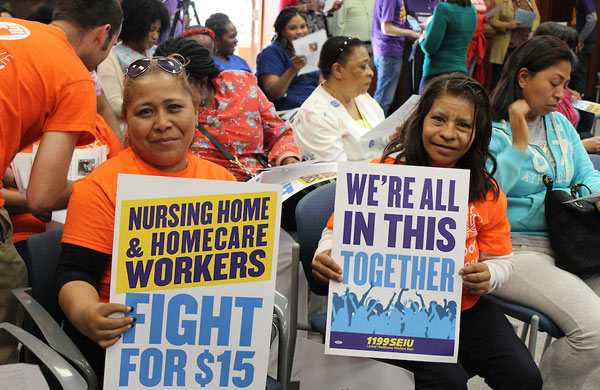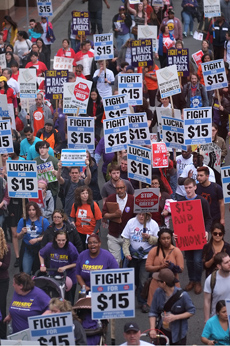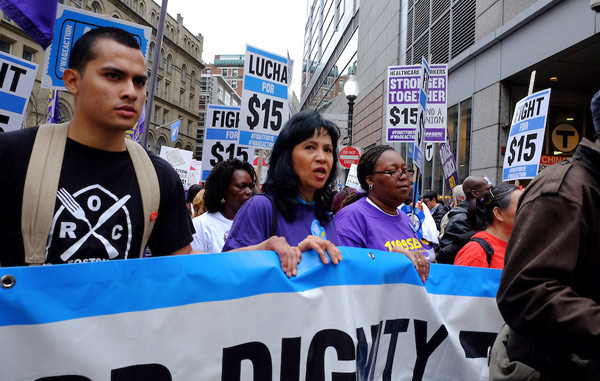1199ers Turn Up The Heat In the Fight for 15!
April 16, 2015
Throughout the regions, thousands rallied for livable wages and union rights.
In a national day of action marked by events in some 200 cities across the country, working people from every labor sector - fast food, academia, hotels and hospitality, child care, homecare, retail and scores of others - rallied, marched, and demonstrated to make heard the growing demand heard for a fair, livable wage of $15 and hour and the right to join a union. Among them were thousands of 1199SEIU members who participated in actions uniowide.
The day began with coordinated demonstrations at McDonald’s restaurants in 40 cities. McDonald’s, along with retail giants like Walmart, has become symbolic corporate greed and its responsibility for America’s growing income inequality. Those actions were followed up by marches and rallies throughout the day.
Tomasina Jessup, a CNA at Hudson Park Nursing Home in Albany, NY, was among the more than two dozen 1199ers who attended a noon rally in front of the Empire State Plaza McDonalds in Albany. Also in attendance were sizable contingents of fast food workers, airport workers, janitors and adjunct professors.
“By now, the public knows that a higher minimum wage is necessary to close the gap where the rich get richer and the rest of us either tread water or drown,” said Jessup. “Worker productivity has soared while wages have barely moved. Our economy is growing, but only people in the top one percent are benefitting from it. We must get back on the right path again, back to the days when the middle class was strong; when Union membership was high.”
1199ers members brought the purple power to demonstrations in at least seven cities between Buffalo and Miami, including a massive rally and march on Manhattan’s Upper West Side, which drew an estimated 15,000 people. (The Union’s Massachusetts region kicked off the protests a day earlier on April 14 with a march and rally several thousand strong.) Overall, some 60,000 people participated in events nationwide; several labor experts noted that it was the largest show of strength by low wage workers in U.S. history.
Some 15,000 working people rallied on and then marched down one of Manhattan’s wealthiest thoroughfares -- Central Park West -- in a historic showing of worker strength and solidarity. Fast food, healthcare, domestic, academic and scores of other workers, including sizable groups from the higher-paid construction trades, proudly donned their Union colors, carried signs and banners in a multitude of languages and colors, walked arm-in-arm and sang, chanted and shook their noisemakers with one goal: to let the City know that it was time to pay workers a fair and livable wage of $15 an hour.
1199SEIU’s homecare members -- who made up a fair portion of the Union’s 3,500- member contingent - raised their voices particularly loud and clear. They’re no strangers to fighting for a living wage. Premier home attendant Celia Justiniano came with client Helen Gibson to the rally.
“Fifteen dollars would change things. In this economy food, rent, all our bills - everything is going up,” said Justiniano. “And ten dollars isn’t a lot for what we do. We take care of everyone. We do everything for our clients. Without us some of them would be totally alone.”
At a pre march rally with 1199SEIU members, New York State Attorney general Eric Schneiderman, who Pres. George Gresham called “a great friend of 1199 who uses his power to help working people every day.”
“There is no fight bigger than raising the minimum wage to help the millions of working families who cannot afford to get by on what they are paid right now,” said Schneiderman. “Here in New York we are subsidizing companies who pay poverty wages and tell their workers to get public benefits – Medicaid, food stamps. That is a disgrace. That is un-American. That is something we will put an end to.”
Melissa Rodriguez, a home health aide with the Visiting Nurse Service marched with purple-sticker covered daughters Isabella, 11, and Esmerelda, 7. Rodriguez makes $10 and hour.
“They see me every day struggling, going to work and coming home with just the bare minimum. Coming out here today and fighting for what’s right shows them that they have a voice too,” said Rodriguez. “$15 an hour would our lives dramatically. I’m a single parent of three kids. Surviving on $10 an hour is no way to live. Fifteen would be a real difference. I wouldn’t have to be on public assistance or request food stamps or any of that.”
New Jersey
New Jersey actions were held in New Brunswick, Newark, Camden, Parsippany, and Atlantic City. In New Brunswick, 1199SEIU hosted an event with over 200 low-wage workers and students from Rutgers University, co-sponsored by nearly 30 labor and community organizations, to launch a New Jersey coalition demanding a $15 living wage and union rights for all.
As at events across the nation, New Brunswick’s event included workers from a range of jobs, including the healthcare and the domestic work. They shared their stories about living paycheck to paycheck and the importance of unions as a path to win $15 an hour. 1199 rank-and-file leader Devika Smith, a certified nursing assistant, was the emcee.
“I work at a nursing home giving care to the most vulnerable people, while earning less than $13 an hour,” said Devika. “I have held the hands of dying residents because they didn’t want to be alone. I’ve taken money out of my own pocket to buy soap, clothes, and fruit for our residents. I want to go to bed at night knowing that I will be able to pay my rent, feed my children, and have enough money left over for a bus ticket to get to work tomorrow.”
“Every morning when I go to work, I watch healthcare workers standing on the bus stop—rain, hail, sleet, or snow,” said Speaker Emeritus Assemblywoman Sheila Oliver came to lend her support workers organizing for $15 and a union. “When I stop at Walgreens after work to pick up something I need, I make note of security guards coming home from work. I make note of working-class people who get up each and every day, working at jobs for the same low wage they’ve been making for years.”
“I’d like to give my 13-year-old son more opportunities to enjoy his childhood, like joining sports teams,” said Chris McDonald, an 1199 member who works as a shift supervisor at Rite Aid. “But there are a lot of things I can’t afford, so I’m joining the Fight for $15 to win a better future for him.”
Over 1,000 protesters joined a march and rally Boston on Tuesday, April 14 – a day ahead of the National Day of Action – to kick the Fight for $15 in to high gear. Boston ranks third in the nation in income inequality. It’s also where the Fight for $15 first picked up real traction and continues to grow through the work of advocates like the Wage Action Coalition, a group of unions and community organizations dedicated to fair wages and free and fair unions of which 1199SEIU is part. The march was one of 12 protests the group has planned for this year to keep the heat on in the fight for livable wages and union organizing rights.
“We aren't starting a moment,” said Sheilah Jones, a Medical Assistant at Boston Medical Center said we are starting a movement!”
<p< Carrying a river of trademark WageAction blue and white signs that read “Fight for $15” and “Lucha Por $15,” Boston protesters moved through the city streets chanting “this is what democracy looks like” and “the people united will never be defeated.” Marchers also carried hand lettered signs with a multitude of messages in several languages, including Spanish and Creole. 1199SEIU hospital and nursing home workers and Personal Care Attendants had been gearing up for the rally for weeks, with events across Massachusetts to give workers the opportunity to share reality of getting by on low pay.
Robert Thompson is a CNA at County Rehab in Lawrence. He makes $11.50 an hour. He spoke at a recent legislative forum in Lawrence where members discussed the emergence of the Fight for $15.
“The most frustrating thing about this industry is the revolving door syndrome. People like myself make $11.50 an hour and after a couple of weeks end up saying ‘I can't do this.’ So we're always short staffed. We're on a floor with 30-35 patients,” said Thompson. “There's 11 people who need complete care, and there's only two of us to care for all of them. We're just doing our best — what we can do. It's constant. People like me are pushing for $15 an hour, but I will continue to do what I love to do.”
Check back for news actions in other regions. For more information or to learn how you can get involved click here.


